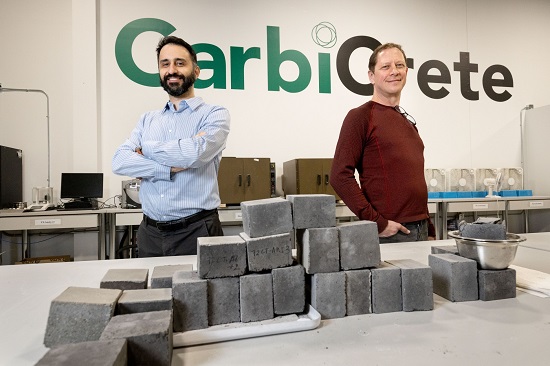 Wednesday, October 2, 2024
Wednesday, October 2, 2024  Wednesday, October 2, 2024
Wednesday, October 2, 2024 
McGill spinoff CarbiCrete has developed a formula for producing Concrete Masonry Units (CMUs) that not only are cheaper to make, faster to cure and stronger than normal CMUs, but that also sequester carbon in their manufacture. Find out more about this silver-bullet technology that is poised to transform the cleantech economy.
There is simply no escaping the fact that 2022 has started out with a completely different sound than a resounding and joyful ‘bang!’ Perhaps we can charitably say it began with a dull, familiar thud – likely caused by the simultaneously slapping of foreheads across the world when the latest wave of pandemic restrictions were announced. As the famous baseball player and manager Yogi Berra once said, “It’s like déjà vu all over again.”
To avoid dwelling on the dour present, let’s turn back the clock to the spring of 2021, a more innocent time when our knowledge of boosters and PCR technology was a trifle less developed. The setting is a warehouse in Lachine, Quebec, the new home of CarbiCrete, a McGill spinoff who, quite simply, aim to build a better world.
A group of visitors is clustered (socially distanced, even in those bygone times) around a glass-walled machine, roughly the shape and size of a phone booth. There is a low-pitched whirring noise that lasts about a minute and then a sudden, satisfying ‘snap!’
“That’s a compressive strength of 65 MPa,” said Mehrdad Mahoutian, CTO of CarbiCrete, and the man who had put one of the company’s samples into the compression device. Mahoutian is very pleased. “That is a very good result,” he confirmed.
The sample in question was part of a new product line the company is developing: paving stones. And while this may not seem to be the most glamorous item to be developing, it is important to understand that these are no ordinary stones.
“The real trick is getting the colour that we want,” Mahoutian elaborated. “Aesthetics are much more important in paving stones than CMUs, so we have to get this right.”
Like a form of modern-day alchemy, CarbiCrete has found a way to turn base materials into ‘gold,’ which in this day and age means captured carbon. To illustrate what this means, a basic understanding of concrete is in order.
First of all, it is fundamental to understand that cement and concrete are not the same. Cement is an ingredient in concrete, a kind of glue if you will, that binds the other materials (what is referred to as aggregate) together.
Human beings have been working with some kind of pourable building material that eventually sets into a permanent and durable form, for millennia. The first use of concrete is believed to have been in what is now called Turkey, some 12,000 years ago.
Romans were experts in the stuff, as exemplified by the Pantheon in Rome. Although well over 2,000 years old, it is to this day the largest domed concrete structure of its kind anywhere in the world.
But the cement formula developed by the Romans was lost to antiquity; what we now know as cement was developed in 1824 by Joseph Aspdin, who combined calcium, silica, aluminum, and iron to make what was eventually called Portland cement.
Since that time, Portland cement – which is mixed with sand and gravel to form concrete – quickly became the construction material of choice, to the extent that is the most consumed substance in the world next to water.